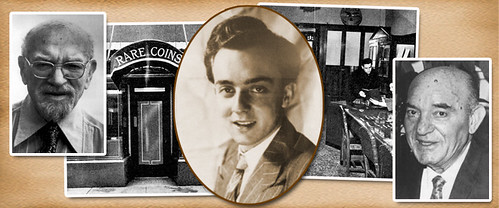
PREV ARTICLE
NEXT ARTICLE
FULL ISSUE
PREV FULL ISSUE
HARVEY STACK'S NUMISMATIC FAMILY, PART 12Harvey Stack's latest Stack's Bowers blog series focuses on growing up in a numismatic family. Here is part 12. -Editor
 Interest in coins really started to grow in 1951 once again. The issuance of Proof sets by the Mint stimulated people to collect. New issues of the Roosevelt dime and Franklin half dollar made collecting these a bit easier. Searching for coins was enhanced by popular Whitman blue coin folders (available for 25 cents each), which provided a great place to store coins found by both adults and children, novices and experienced collectors. The folders were punched with spaces for each date and mint issued for each design, properly labeled. They encouraged people to search their change and as people became more interested in collecting, they would visit coin shops to "fill in the holes" There was revived interest in collecting gold coins, from the United States as well as the rest of the world. This was facilitated by the government, who had originally required the surrender of gold in the 1933-34 period, but by this time felt that the "Intent of the law was satisfied, hoarding abated, and they will relax on collecting gold coins." Many new collections were started and demand increased. The down side was that suddenly the market was flooded with numerous counterfeits. Experienced professional numismatists could recognize the difference between coins that were fake and those that were genuine. Those with a good reputation for selling genuine coins received additional business. At Stack’s we had visits from agents of the Secret Service to help them verify coins they found in local jewelry stores and hock shops. In addition to verification, they wanted to learn how to tell if coins were counterfeit. Their previous training had mostly related to paper currency, and not as much on counterfeit coins, especially those that were no longer in general circulation. I was a government witness at several trials of those who were selling counterfeits, after the coins were seized. It was an important job, as we wanted to be sure that counterfeits would not damage the numismatic market. In the beginning, the most popular counterfeits seen were $1 gold, $2.50 and $3 gold. The gold dollars were sold to Spanish -Americans who wanted them for wedding gifts, the $2.50 (especially Liberty Head design), went mostly to Asia. The $3 gold pieces found their way into collections and it could be hard for buyers to tell the difference between real and fake coins. Numerous counterfeit foreign gold coins also appeared, mostly for jewelry purposes. They were priced close to gold melt for the genuine coin, but the counterfeits were of lower carat gold; the profit was in the difference in gold content. It was determined that these were mostly from Milan and Beirut, where a big trade had developed in false coins. The economy had gotten beyond its wartime status, and new collectors were attracted to the hobby at the same time as old collectors were finding their way back into numismatics. During this period and for several years afterward the market was very good for original gold coins along with our rarer numismatic coins. To read the complete article, see: Wayne Homren, Editor The Numismatic Bibliomania Society is a non-profit organization promoting numismatic literature. See our web site at coinbooks.org. To submit items for publication in The E-Sylum, write to the Editor at this address: whomren@gmail.com To subscribe go to: https://my.binhost.com/lists/listinfo/esylum All Rights Reserved. NBS Home Page Contact the NBS webmaster 
|